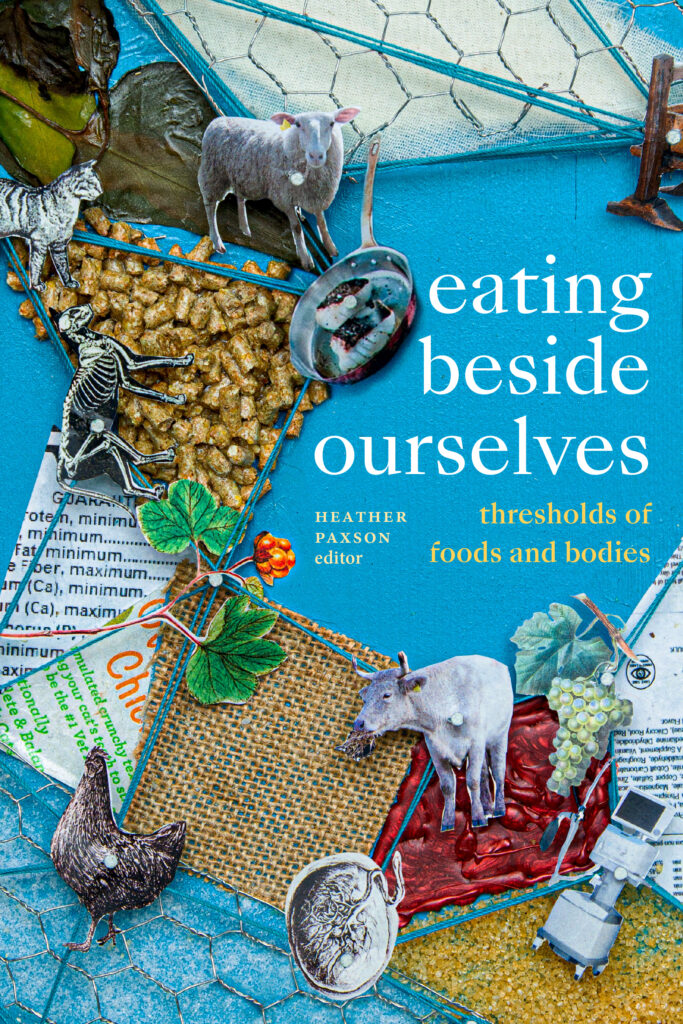Reviewed Book
Eating Beside Ourselves: Thresholds of Foods and Bodies By Heather Paxson, Durham, NC: Duke University Press. 2023. pp. 248.

Jessica Hardin
Rochester Institute of Technology
This is a book ostensibly about eating, but not eating in the ordinary sense. Eating is refigured as actions and processes of ingestion, absorption, incorporation, and transformation. It questions the making of wholes by way of a multispecies approach inflected through science and technology studies. The central analytic––that of thresholds––is suited for this kind of endeavor, as thresholding brings attention to boundary-making and boundary-crossing; although thresholding might draw attention to the tipping points of category change, the chapters are critically focused on destabilizing categorical analysis to focus on “the partiality of food’s capacity to make and to relate, and to the messy unevenness of commensality” (7).
On this first point, the book makes an explicit contribution to food studies by questioning the centrality of culture, intention, and meaning in how we approach commensality. The case that makes this point most pointedly is Marianne Elisabeth Lien’s chapter about edibility in Arctic Norway. Bringing together decades of ethnographic fieldwork, Lien tells stories that could be told through the lens of taxonomic ethnic identity-making around how the categories of “Norwegian” and “Sámi” have historically been forged through the practice of picking and sharing cloudberries. Instead, she argues that eating can be productively figured as a process of making such things as “food,” “eater,” “relation,” and “social person” (115). One of the most ethnographically vivid examples is Lien’s description of several videos she recorded of an emergency slaughter of a reindeer calf after a failed earmarking (a family-specific cut and an ear tag that indicate human ownership). The detailed vignettes demonstrate what Lein sees as the constitution of meat through relations of sharing. In other words, the calf became edible not as it was slaughtered and broken into relative parts but through the various discussions that precipitated giving pieces of the calf, like the tongue, to individual people—moving animal parts from waste to delicacy (121−26).
Lein’s story of the making of meat stands in contrast to stories told by Alex Blanchette about the making of feline palatants from hog viscera. Blanchette uses a more-than-human approach to understand industrial food systems––hog monocultures, specifically––as more than hegemonic units of mass production. Instead, by tracing how cats and pigs relate through the creation of feline pleasure, it is possible to see the expanding qualities of monocultures as creating ever more needs rooted in hog bodies, what he describes as transcorporeal capitalism.
While these chapters are clearly grounded in ongoing food studies paradigms, Eating Beside Ourselves brings new materialities to the table as well. From fungal matrix (Heath) to breath (Solomon) to placenta (Yates-Doerr), these chapters hang delicately in a book where eating is both centered and decentered. Emily Yates-Doerr tells the story of coming to learn about and think with her own placenta but ultimately mobilizes the placenta as a figure that helps us understand broader relations of feeding. It is, she writes, “singular and shared, individualized and distributed, and nurturing and destructive” (177).
Beyond the conceptual refiguring of eating and feeding relations, the organization and writing of the volume are similarly concerned with tending to writerly thresholds. In intercalary explorations, the authors of adjacent chapters write together, weaving together the threads of chapters––tending to cross boundaries between chapters by stitching together resonate ideas in ways the reader is ordinarily left to do in isolation. There is certainly a writerly objective in these thresholding sections, but there is also a political impact––making evident how the work of theory-making is always dialogic and conversational. I appreciate the authors narrating what read like spirited conversations, a batting back and forth of ideas, rooted in our anthropological canon and pulling out themes not explicit in individual chapters but that come from thinking about the collection as a whole. For me, there is a broader politics to writing the social life of workshops, and their artifacts, into collections like this that remains implicit. By extension, the same critique holds for the analytic of thresholds.
Amy Moran-Thomas’s powerful chapter narrates sugar’s many changing forms, from the white refined substance found in warehouses in London to the sweet smell of urine of people living with high levels of glucose in Belize. She uses thresholds to deconstruct boundaries that have until recently limited analysis of diseases like diabetes to “health” or garbage in the sea to “environmental pollution” making evident the need for a planetary perspective that shows the falsity of positing such boundaries in the first place. The political potential of thresholds in this chapter is quite evident but, on the whole, in the volume, the political potential is understated. Inspired by MAQ’s articulation of values, I ask how might thresholds be employed to “undo the structures of white supremacy and (settler) colonialism” that shape so much of the ethnography presented?
Eating Beside Ourselves will prove to be a new classic in food studies, offering medical anthropology a fresh analytic tool in thresholds that helps us articulate boundary work in new ways. Importantly, this analytic brings in the material and more-than-symbolic in ways that can yield insightful and future-making theory.